Hendrick Goltzius
Hendrick Goltzius, or Hendrik, (German: [ˈgɔltsi̯ʊs]; Dutch: [ˈɣɔltsʲiœs]; January or February 1558 – 1 January 1617) was a German-born Dutch printmaker, draftsman, and painter. He was the leading Dutch engraver of the early Baroque period, or Northern Mannerism, lauded for his sophisticated technique, technical mastership and "exuberance" of his compositions. According to A. Hyatt Mayor, Goltzius "was the last professional engraver who drew with the authority of a good painter and the last who invented many pictures for others to copy".[1] In the middle of his life he also began to produce paintings.
Hendrick Goltzius | |
|---|---|
 Self-portrait (c. 1593–94) | |
| Born | Hendrick Goltz January/February 1558 |
| Died | 1 January 1617 (aged 58–59) |
| Occupation | Printmaker, draftsman, painter |
| Known for | Use of the burin tool for engraving |
| Style | Northern Mannerism |
Biography
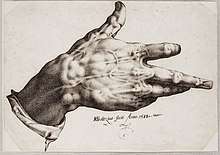
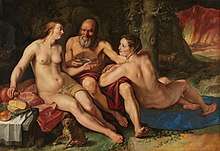
Goltzius was born near Venlo in Bracht or Millebrecht, a village then in the Duchy of Julich, now in the municipality Brüggen in North Rhine-Westphalia. His family moved to Duisburg when he was 3 years old. After studying painting on glass for some years under his father, he learned engraving from the Dutch polymath Dirck Volckertszoon Coornhert, who then lived in Cleves. In 1577 he moved with Coornhert to Haarlem in the Dutch Republic, where he remained based for the rest of his life. In the same town, he was also employed by Philip Galle to engrave a set of prints of the history of Lucretia.
Goltzius had a malformed right hand from a fire when he was a baby (his drawing of it is below), which turned out to be especially well-suited to holding the burin; "by being forced to draw with the large muscles of his arm and shoulder, he mastered a commanding swing of line".[2]
In the 1580s, Goltzius with his friends van Mander and the painter Cornelis van Haarlem, founded an art academy in Haarlem in emulation of those in France and Bologna, where the human figure could be studied from life and to provide a meeting-place for artists to discuss both practice and aesthetics.[3]
At the age of 21 he married a widow eight or nine years his senior, whose money enabled him to establish an independent business at Haarlem; but his unpleasant relations with her so affected his health that he found it advisable in 1590 to make a tour through Germany to Italy, where he acquired an intense admiration for the works of Michelangelo. He returned to Haarlem in August 1591, considerably improved in health, and worked there until his death.
His portraits, though mostly miniatures, are masterpieces of their kind, both on account of their exquisite finish, and as fine studies of individual character. Of his larger heads, his life-size self-portrait is probably the most striking example.
Goltzius brought to an unprecedented level the use of the "swelling line", where the burin is manipulated to make lines thicker or thinner to create a tonal effect from a distance. He also was a pioneer of "dot and lozenge" technique, where dots are placed in the middle of lozenge shaped spaces created by cross-hatching to further refine tonal shading.
Hollstein credits 388 prints to him, with a further 574 by other printmakers after his designs.
In his command of the burin, Goltzius is said to rival Dürer. He made engravings of Bartholomeus Spranger's paintings, thus increasing the fame of the latter – and his own. Goltzius began painting at the age of forty-two; some of his paintings can be found in Vienna. He also executed a few chiaroscuro woodcuts. He was the stepfather of engraver Jacob Matham. He died, aged 58, in Haarlem.
Public collections
Most major print rooms will have a group of Goltzius's many engravings.
- Museum Boijmans Van Beuningen, Rotterdam[4]
- Rijksmuseum Amsterdam[5]
- Blanton Museum of Art, Austin[6]
Gallery
 Horatius Cocles, from The Roman Heroes, 1586
Horatius Cocles, from The Roman Heroes, 1586 Icarus (1588) from the series The four disgracers
Icarus (1588) from the series The four disgracers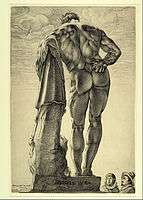 Engraving of the Farnese Hercules, c. 1598
Engraving of the Farnese Hercules, c. 1598_-_Sine_Cerere_et_Libero_friget_Venus_(Without_Ceres_and_Bacchus%2C_Venus_Would_Freeze)_-_Google_Art_Project.jpg) Sine Cerere et Baccho friget Venus (Without Ceres and Bacchus, Venus Would Freeze), 1600–03
Sine Cerere et Baccho friget Venus (Without Ceres and Bacchus, Venus Would Freeze), 1600–03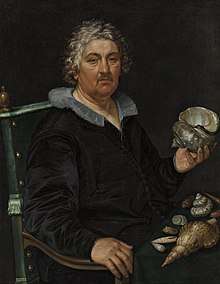 Portrait of the Shell Collector Jan Govertsen van der Aer (1603)
Portrait of the Shell Collector Jan Govertsen van der Aer (1603)- Jupiter and Antiope (1612)
 The Fall of Man
The Fall of Man- Hercules Killing Cacus, a chiaroscuro woodcut, 1588
 A Foxglove in Bloom, 1592, pen and brown ink on laid paper, National Gallery of Art, Washington, D.C.
A Foxglove in Bloom, 1592, pen and brown ink on laid paper, National Gallery of Art, Washington, D.C.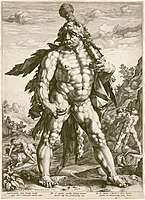 The Great Hercules, 1589
The Great Hercules, 1589
Notes
Citations
- Mayor, no. 420
- Mayor, no. 418. Other writers take his friend and biographer Karel van Mander's account to mean that he engraved with his right hand and drew with his left. Google Books
- Marjorie B. Cohn, ' An Interpretatino of Four Woodcut Landscapes by Hendrick Goltzius', Print Quarterly, XXXI, 2014, 2, p. 149.
- Collection Museum Boijmans Van Beuningen
- Collection Rijksmuseum
- "Archived copy". Archived from the original on 22 July 2015. Retrieved 17 July 2015.CS1 maint: archived copy as title (link)
References

- A Hyatt Mayor, Prints and People, Metropolitan Museum of Art/Princeton, 1971, ISBN 0-691-00326-2
- Marjorie B. Cohn, 'An Interpretation of Four Woodcut Landscape by Hendrick Goltzius,'Print Quarterly, XXXI, June 2014, pp. 144–155.
Further reading
- Liedtke, Walter A. (1984). Flemish paintings in the Metropolitan Museum of Art. New York: The Metropolitan Museum of Art. ISBN 0870993569. (see index).
External links
| Wikimedia Commons has media related to Hendrick Goltzius. |